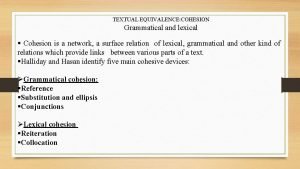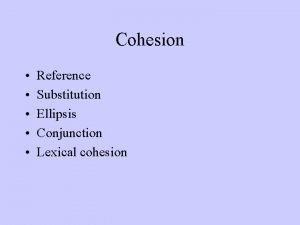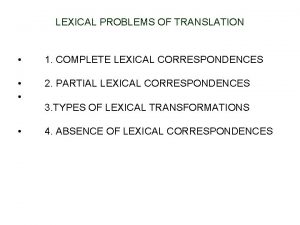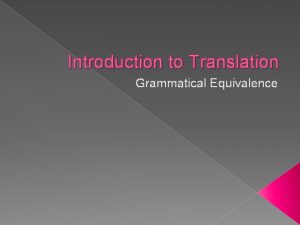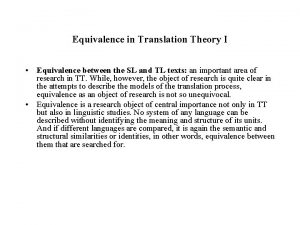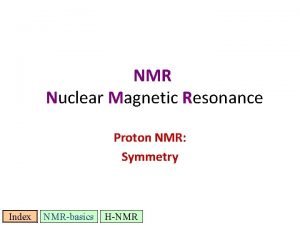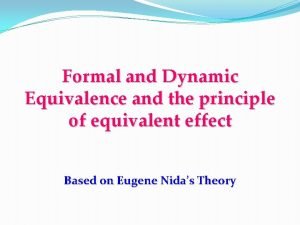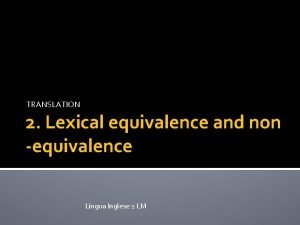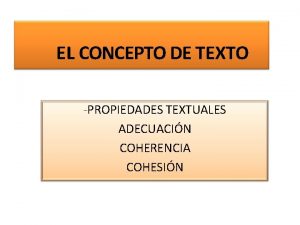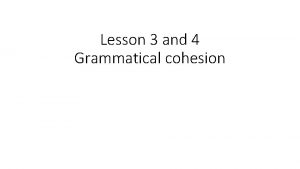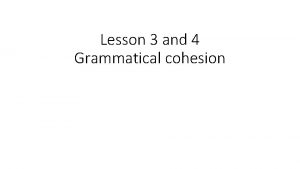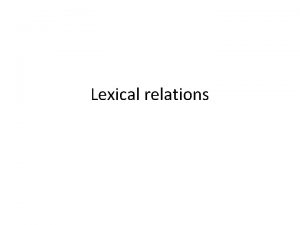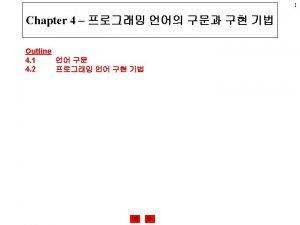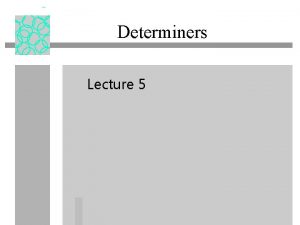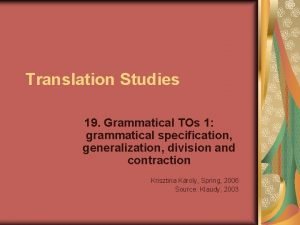TEXTUAL EQUIVALENCE COHESION Grammatical and lexical Cohesion is
















- Slides: 16

TEXTUAL EQUIVALENCE: COHESION Grammatical and lexical § Cohesion is a network, a surface relation of lexical, grammatical and other kind of relations which provide links between various parts of a text. §Halliday and Hasan identify five main cohesive devices: ØGrammatical cohesion: §Reference §Substitution and ellipsis §Conjunctions ØLexical cohesion §Reiteration §Collocation

Reference q. Textual sense Relationship of identity which holds between two linguistic expressions. • Mrs Thatcher has resigned. She announced her decision this morning She points to Mrs Thatcher

The most common reference items in English (and other languages) are pronouns). They refer back anaphorically (or forward, cataphorically) to an entity which has already been mentioned (or which has to be mentioned). §Third –person, this, that , those, etc. • Mrs Thacher has resigned. This delighted her opponents • Third –person, this, that , those, etc.

Lily, the carateker’s daughter, was literally run of her feet. Hardly had she brought one gentleman into the little pantry behind the office on the ground floor and helped him off with his overcoat, that the weezy haal-door bell changed again and she had to scamper along the bare hallway to let in another guest. It was well for her she had not to attend to the ladies also. But miss Kate and miss Julia had thought of that and had converted the bathrtoom upstairs ijnto the ladies’ dressing room (Gente di Dublino J. Joyce). • Her Lily • She Lily • Him one gentleman • His him • She Lily • Her Lily • She Lily • That to attend to the ladies also

There is a continuum of cohesive elements that may be used for referring back to an entity already mentioned in the discourse: Ø The continuum stretches from full repetition at one hand of the scale to pronominal reference at the other: • There is a boy climbing that tree: • The boy is going to fall if he doesn’t take care (repetition) • The lad’s going tofall if he doens’t take care (synonim) • The child’s is going to fall if he doens’t take care (superordinate-hyperonim) • The idiot’s is going to fall if he doens’t take care (general word) • He’s going to fall if he doens’t take care (pronominal reference)

ØWhat is the implication for a translator? ØThe distribution of pronouns vs full noun phrases differ dramatically from one discourse to another’ (Cook 1992). ØAdvertising discourse prefer repeating the name of object instead of using pronominal reference: “one obvious function of the repetition is to fix the name of the product in the mind, so that it will come to the lips of the purchaser lost for a name” (Cook 1992: 154) ‘Parallelisms and repetitions […] ear-catching […] and make advertising style more entairtaining and pleasurable’ (van Leeuwen 2005: 152)

Substitution and ellipsis Unlike references, they are grammatical rather than semantic relationships. § In substitution one element is replaced by another item: • I like movies • And I do Do is a substitute for I like movies ØItems commonly used in substituions: do, one, the same; • You think Josh already knows? I think everybody does (does replaces knows) • My axe is too blunt. I must get a sharper one. (one replaces axe) • A) I’ll have two poached eggs on toasts, please. • B) I’ll have the same (The same replaces two poached eggs on toasts)

Ellipsis involves the omission of an item. An item is not replaced and it is left usaid although it is nevertheless understood. • Joan brought some bread and Catherine some meat. (elliptical item: brought in the second clause) • Here are thirteen cards Take any. Now give me any three. (elliptical item: cards after any in the second clause and cards after any three in the third clause) • Have you been swimming? Yes, I have. (Elliptical item: been swimming in the second clause) (Halliday and Hasan 1976).

What are the implication for a translation? The translator need to be aware that there are different devices for creating cohesion: § Reworking the textual norms of the target language. Ø Unlike the Italian grammatical system, the English system makes very few distinctions in terms of number, gender, and verb agreement. Lexical repetition is therefore a much safer option in cases where ambiguiity of reference may arise and in contexts which do not tolerate ambiguity. § The textual norms of different genre suggest certain options and rules. Ø In legal texts and semi-legal texts, it has become the norm to use lexical repetition even in instance where no ambiguity might result from using pronominal reference.

Conjunctions Ø Formal markers employed to relate sentences, clauses, and paragraphs to each other. Unlike references, substitution and ellipsis, used to supply missing information, conjunctions signals the way the writer wants to relate chunks of the text. q. The main relations are summarized below: Ø additive: and, or, also, in addition, furthermore, besides, similarly, likewise, by contrast, for instance. ØAdversative: but, yet, however, instead, on the other hand, nevertheless, at any rate, as a matter of fact. ØCausal: so, consequently, it follows, for, because, under, the cirmustances, for this reason. ØTemporal: then, next, after that, on another occasion, in conclusion, an hour later, finally, at last. ØContinuatives: now, of course, well, anyway, surely, after that.

Conjunctions What are the implications for a translator? Ø the use is different according to the different genres: some genres are “more conjunctive than others” (Baker 2011: 205): ØEach genre has its own preference for certain types of conjunctions. Example: Conjunctions in general, and causal conjunctions in particular: since, for , because, in science are relatively infrequent. This is explained by the high level of assumed knowledge and by the need to give the impression of objectivity. Journalism: lack of causal conjunctions for reason of space and the need not to give an impression of overt explanation of reported events risking the danger of legal suits and liability.

Lexical cohesion Refers to the role played by the selection of vocabulary in organizing relation between the text. Halliday and Hasan divide them in two main categories: §Reiteration: repetition of lexical items. §Collocation: involves a pair of lexical items that are associated with each other in some way.

Lexical cohesion §Reiteration: repetition of lexical items. A reiterated item may be a repetition of an earlier item, a synonim, a near synonim, a superordinate, a general word. In this sense, reiteration can be placed along the same continuum as reference (except for pronominal reference). • There is a boy climbing that tree: • The boy is going to fall if he doesn’t take care (repetition) • The lad’s going tofall if he doens’t take care (synonim) • The child’s is going to fall if he doens’t take care (superordinate-hyperonim) • The idiot’s is going to fall if he doens’t take care (general word) ØReiteration is not the same a reference. §Reiteration: does not necessarily involves identity. §Reference involves identity.

Lexical cohesion §Reiteration: . • There is a boy climbing that tree: • The boy is going to fall if he doesn’t take care (repetition). Boys can’t be so silly. § the repetition of boys would still be an intance of reiteration, even though the two items would not be referring to the same individual(s).

Lexical cohesion §Collocation: Subclass of lexical cohesion covers any instance which involves a pair of lexical items associated with each other in the language in some way. Ø various kinds of oppositness of meaning: e. g. love/hate, order /obey, boy/girl; § par-whole meronym relations: car/ brake, body/arm, bicycle/wheel; §Part-part relationship: mouth/chin, verse/chorus; §Co-hyponimy: red/green(colour), chair/table (furniture);

Lexical cohesion Implication for translation: §Collocation: Impossible to reproduce a nework of lexical cohesion in a target text which is identical to that of the source text. The result is that the tranlator should add or delete information or reword part of the souce text. There is a general tendency in translation to raise the level of explicitness: that is increasing the level of redundancy in the target text “[…] as practiced by language learners, non professional tranlators” (Blum-Kulka)
 Textual equivalence examples
Textual equivalence examples Lexical meaning and grammatical meaning
Lexical meaning and grammatical meaning Lexical and grammatical features
Lexical and grammatical features Substitution and ellipsis
Substitution and ellipsis Lexical problems in translation
Lexical problems in translation Disticntion
Disticntion Principle of equivalence in translation
Principle of equivalence in translation Verbal substitution examples
Verbal substitution examples Text coherence in nlp
Text coherence in nlp Enantiotopic vs diastereotopic
Enantiotopic vs diastereotopic Dynamic and formal equivalence
Dynamic and formal equivalence Catford formal correspondence and textual equivalence
Catford formal correspondence and textual equivalence What is non equivalence in translation
What is non equivalence in translation Vocabulary in discourse
Vocabulary in discourse Discourse analysis in linguistics
Discourse analysis in linguistics Propiedad textual
Propiedad textual Mecanismos de cohesion
Mecanismos de cohesion
